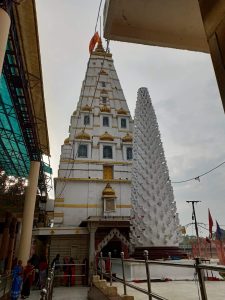Mandsaur’s Pashupatinath; A Rare Shivaling.
 ARUN KUMAR JOSHI
ARUN KUMAR JOSHI
Shiva is known by many names such as Viswanatha (lord of the universe), Mahadeva, Mahandeo, Mahasu, Mahesha, Maheshvara, Shankara, Shambhu, Rudra, Hara, Trilochana, Devendra (chief of the gods), Neelakanta, Subhankara, Trilokinatha (lord of the three realms), and Ghrneshwar (lord of compassion). Shiva’s names represent different dimensions of who he is.There are 108 names of Shiva Yuuui
Lord Shiva is revered with the hundreds of synonyms. Shankar the Well Wisher, Mahadev The lord of lords and Parmeshwar The Supreme God. Shiva is a part of Trimurty the Hindu trinity that includes Brahma and Vishnu. Shiva is the Supreme Lord who creates, protects and transforms and destroys the universe yet revered along with Vedic Gods Vishnu and Brahma.
Lord Shiva is also known as Pashupatinath, the lord of animals. The Pashupatinath tradition is one of 6 major tradition within Shaivism. The Pashupatinath idol is a complete merger of Rudra and Shiva with eight faces. The eight faces represent the various aspects of Shiva in regional Shaivism theology such as Bhava, Pashupati, Mahadeva, Isana, Rudra, Sharva, Ugra and Asani. It is referred as Ashtamukha or Ashtamurti. There are two Pashupatinath temples which are well known in the world. One of course is very popular as located at Kathmandu in Nepal while another is situated at Mandsaur in the western side of central Indian state of Madhya Pradesh. The Mandsaur Shivalingam is much larger than Kathmandu Temple.
The ancient city of Mandsaur has a glorious past in the Indian History.
The City surrounded by villages with fields where farmers grow opium since ancient times.It was found that the stone on which Udaji used to wash clothes was actually a very beautiful huge Shivlinga with eight faces and he was washing clothes on the broad head of idol. When people of Mandsaur tried to carry the idol to Ujjain, the bullocks did not move a mile. That night Udaji again dreamt of Lord Shiva instructing him that the temple should be built there only. This is the beginning of constructing Pashupatinath Temple at Mandsaur.
The eight face Shiva found in the reconstructed Pashupatinath temple is from the 1st millennium CE and possesses a rare iconography. According to some historians, this Mandsaur linga is likely from the early 6th century. It was the same time when Nepal kings constructed Kathmandu Pashupatinath temple. The eight-faced idol is still the same as it was left by the sculptors in that era, the lower faces have been partially worked upon and they are not as clear as the upper four faces. The shrine has four doors in four directions. The temple built on the river is 90 feet long, 30 feet wide and 101 feet tall. On top of the temple is a 100 kg gold plated pitcher. Every monsoon the water level in the Shivna river rises to touch the holy Shiv Ling of lord Shiva. This phenomenon is termed as “Jalaabhishek” which means worshiping god through the water.
A question comes to mind whether any temple existed in the area in the ancient times ! Certainly the archeological antiquities and ancient historical references in and around area indicate it. The history of the site is traceable to the 2nd-century CE when it was already a Hindu pilgrimage site and region was known as Dashapura as per ancient inscriptions found around Mandsaur. It is mentioned by the ancient Indian poet Kalidasa.
The inscriptions also suggest that the sculpture and temples of Mandsaur were built with resources pooled by the common people, such as silk weavers of Dashapura, who had settled there from Gujarat. However, these inscriptions mention a Surya (Sun) temple, a Vishnu temple and others. They do not mention the Pashupatinath temple.
The discovery of Yashodharman’s early 6th century two pillars with Sanskrit inscriptions on them from a village Sondani about 4 kilometers from Mandsaur is another solid evidence of the era during which this beautifull Shivalinga was carved.
The Mandsaur inscription praises Yasodharman, describes him as having rescued the earth from rude and cruel kings of the Kali age, who delight in viciousness. It also throws lights on the contemporary times.

